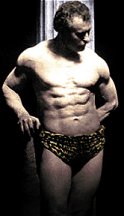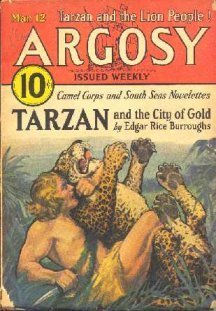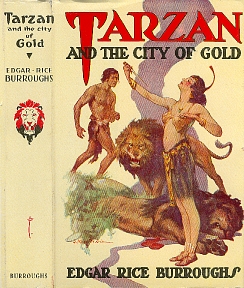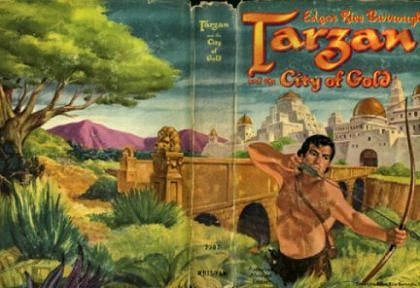A third probable source
would be from the
Legends of Charlemagne volume of Bulfinch's
Mythology. In the last Bulfinch tells of a City Of Gold in which
an enchantress retains the leading paladins of Charlemagne. That
story seems to be based on Homer's story of Circe and Odysseus, or Ulysses
in the Roman telling, so Burroughs combines both stories in his own enchantress,
Nemone, of The City Of Gold. One may take the City Of Gold to be The Sacred
City of the Iliad.
The rival kingdoms of Cathne
and Athne -- my spell check just pointed out to me that Athne respelled
is Athen which is very close to Athene or Athens -- have Greek-sounding
names reinforcing the Homeric connection.
While the sexual symbolism of
Leopard Men is dark and brooding placed in a swamp not unlike the
Lernean swamp of Greek mythology in which Heracles fought the furious female
Hydra, the
City Of Gold is much brighter and airier, more intellectual
than the darker urges of the subconscious.
Having now read many of the Tarzan
novels four - five and even six times I am astonished at how well they
maintain their freshness from reading to reading. Rather than weary
me, each reading is a fresh experience that opens a whole new vista of
possibilities. The more I seem to understand of what I'm reading
the more significance the words have as the story seems to rise from the
page to form concrete living images, as it were.
In this novel especially I am
impressed by the pacing, the effort put into preparing the scenes and the
masterly execution in which each word assumes its independent value almost
as though ERB had put as much care into word selection as, say, the poet
Tennyson. Of course we know ERB read Tennyson as well as other verse
and poetry while also being familiar with song lyrics. Thus while
writing prose he is able to maintain a poetic intensity.
The opening scene is an excellent
example of his skill. Tarzan is out hunting when he is spotted by
some shiftas.
He's in Ethiopia at the end of the rainy season. We aren't told why
he is there but he has commanded Nkima and Jad-Bal-Ja to stay home.
As a corollary, just before he leaves Emma two years later he will take
a solo vacation to the mountains of Arizona. The spatial arrangement
conveyed is this scene is that of Tarzan between the shiftas and his prey.
While he is silently stalking the prey the shiftas are more noisily stalking
him. The movement of the shiftas which can be seen by the prey but
not by Tarzan who has his back to them is caught by the prey who looks
past Tarzan at the shiftas. Tarzan noticing the prey looking beyond
him also looks back to spot the shiftas stalking him.
The spatial concepts involved
are astonishing while three views of time are also evident. I only
picked up on this aspect with my fifth reading. My interest was thus
piqued and heightened so that the novel took on an entirely new aspect.
The scene as written is so well paced and spaced that it made a vignette
I'm sure I shall never forget, while I now long to duplicate such a scene
in my own writing.
The patient lulling slow pace
of Tarzan's hunt was now broken. As Tarzan's quarry fled, the action
between Tarzan and the shiftas became fast, furious and frenzied, while
the sexual symbolism bursts into one's consciousness.
As the shiftas bear down upon
him Tarzan realizes that he cannot escape by running. If he could
have he would have because as Burroughs never tires of noting there is
no disgrace in running from a force majeure. Instead Tarzan shot
arrows among the shiftas. Then as a shifta bore down on him lance
leveled:
There could be no retreat
for Tarzan; there could be no sidestepping to avoid the thrust, for a step
to either side would have carried him in front of one of the other horsemen.
He had but a slender hope for survival, and that hope forlorn though it
appeared, he seized upon with the celerity, strength and agility that make
Tarzan Tarzan. Slipping his bow string about his neck after his final
shot, he struck up the point of the menacing weapon of his antagonist,
and grasping the man's arm swung himself to the horse's back behind the
rider.
Abilities like that make Tarzan
Tarzan and I'm sure such a feat could be done in reality as in the imagination
although possibly not if Tarzan had had the bunchy muscles of the professional
strongman. Smooth ones flowing beneath the skin like molten
metal are undoubtedly a prerequisite.
Dispatching the shifta Tarzan
is now symbolically seated on a horse. The horse directly plunges
into a river to swim to the other side. In mid-stream the horse and
rider are attacked by a crocodile that Tarzan kills or disables.
Emerging from the river Tarzan gallops into a forest where he abandons
the horse for the security of the trees.
There in a short passage we have
a wealth of symbolism that tells in a few paragraphs what ERB could have
developed in many chapters if told in straight prose.
The horse is a symbol of the
female. Thus Tarzan as Animus is symbolically united with his Anima.
The horse plunges into the river, which is also a female symbol representing
the waters of the subconscious. Still mounted Tarzan is in the conscious
sphere above water while the horse is submerged in the subconscious.
The crocodile, also a female symbol representing the greedy, devouring,
emasculating aspect of femininity attacks. The horse turns upstream
in an attempt to flee the croc. Tarzan strings his bow firing an
arrow, as a masculine symbol, into the crocodiles mouth disabling it thus
escaping the disabling aspect of the feminine while with strange violence
sending the arrow down the throat. One has to think about these things.
The horse scrambles up on the
opposite bank signifying a change in life, then gallops into the forest
of the subconscious where one goes in search of oneself. The forest
here is the same as all those underground mazes in Burroughs' corpus.
Once in the forest Tarzan abandons
the horse, or Anima for the security of the trees where he is above it
all. Apparently there is a deep cleavage between his Animus and Anima.
Now begins a very strange encounter. Burroughs apparently felt he
left something of himself on the other side of the river so he goes back
for it.
Coming upon the camp of the shiftas
he notices that they have a bound captive. As this appears to be
what he returned for one can only speculate that the bound captive is an
aspect of himself. Perhaps the captive represents his marriage to
Emma in which he is in the bonds of matrimony wishing to escape them.
Tarzan takes action. At this point Burroughs offers this rather remarkable
passage describing the ape-man. P. 15:
It was difficult for Tarzan
to think of himself as a man, and his psychology was more often that of
the wild beast than the human, nor was he particularly proud of his species.
While he appreciated the intellectual superiority of man over other creatures,
he harbored contempt for him because he had wasted the greater part of
his inheritance. To Tarzan, as to many other created things, contentment
is the highest ultimate goal of achievement, and health and culture the
principal avenues along which man may approach this goal. With scorn
the ape-man viewed the overwhelming majority of mankind which was wanting
in one essential or the other, when not wanting in both. He saw the
greed, the selfishness, the cowardice, and the cruelty of man; and, in
view of man's vaunted mentality, he knew that these characteristics placed
man upon a lower spiritual scale than the beasts, while barring him eternally
from the goal of contentment.
In the above quote ERB outlines
the central problem of mankind. In the evolution of mankind from
beast to homo sapiens the much vaunted mentality of HS has failed to make
the transition from the pure mentality of the beast to that of, essentially,
the god. In other words his origins are dragging him back as he tries
to make the leap to the next stage of development.
While having a godlike intelligence
rather than using it to elevate himself above primal desires as the direction
of the nineteenth century was going, Freud undercut the drive to perfection
dragging mankind back down to primal desires. This is Freud's great
crime for which he should be burned in his effigy of Satan once a
year in a great world wide holiday. Thus as Man uses his intelligence
to get at the root of things, and I think we're very close to understanding
all, Man's primal desires lapsing back into the 'unconscious' of Freud,
and make no mistake the current conception of the unconscious is of Freud's
personal devising, devise even more fiendish ways as that knowledge increases.
Thus rather than aspiring toward a spiritual contentment Man chooses to
give in to desires that lower him beneath the hyena.
Thus for Tarzan, who has attained
spiritual contentment, looks with scorn and contempt on the humanity of
his fellows preferring to think of himself as a 'spiritually pure' beast.
While this attitude is a theme
throughout this oeuvre and the corpus as a whole perhaps this rant was
sharpened by the developing difficulties at MGM. Shortly after this
was written
Tarzan, The Ape Man hit the screens scrambling ERB's
vision of Tarzan forever. The screen Tarzan has no intellect.
In Tarzan's Desert Adventure Boy even has to read Jane's letter
to him.
On his way to the shifta camp
the ever-present Numa is between him and the desperadoes. Taking
to the trees of the forest to pass over Numa he spots a strangely garbed
bound man in the shifta camp. Still smarting because of his lost
quarry and operating on the primitive logic that since the shiftas had
deprived him of dinner it would only be right to deprive them of something
they wanted, he decides to free the captive.
He was about to fail in his attempt
when the ever present Numa saves his skin by attacking the shifta camp.
In the confusion Tarzan and the prisoner escape. The man turns out
to be an Athnean named Valthor. Having escaped they must put up for
the night. Sheeta the panther is abroad. As David Adams is
wont to point out, for Burroughs Sheeta is a sexual symbol so the next
scene has strong homoerotic overtones.
The question is who does Valthor
represent. He is curiously vague in personality. As Burroughs
was obsessed with the Jekyll and Hyde notion at this time I suspect that
Valthor is an aspect of Burroughs' own personality with some sort of relation
to Tarzan as Jekyll to Hyde. Valthor's life is saved as Sheeta leaps
for him so that one feels he may be related in some way to Stanley Obroski,
another alter ego of Tarzan, who will actually die in the succeeding novel,
Tarzan And The Lion Man.
In this novel, in putting up
for the night, Tarzan with his superior junglecraft, finds a tree where
two horizontal branches fork. He cuts some smaller limbs to form
a pallet for himself for the night. He had eaten but he is unconcerned
whether the able bodied Valthor has eaten or not. Tarzan does not
hunt for other men. If he hadn't already eaten he would have made
a kill and shared the abundance.
Valthor lies down on the ground.
Sheeta is watching silently. So silently even Tarzan does not hear
him breathe, until readying himself to spring, he quietly brushed a leaf
or two. Tarzan hears for his ears are not as yours or mine.
As Sheeta launches herself on Valthor Tarzan shouts a warning while rolling
from his pallet to descend on Sheeta's back.
Now, this scene replicates a
similar scene in The Beasts Of Tarzan when Tarzan leaps on Sheet's
back in midair as she was about to leap on the ape, Akut. I hadn't
thought of homoerotic overtones between Akut and Tarzan but they may be
there. It may be significant that Akut later became the mentor of
young Jack Clayton otherwise known as Korak The Killer.
In the instance of Akut, the
ape became a sort of vassal of Tarzan, while in this story Tarzan and Valthor
become fast friends although the relationship is one of superior to inferior
-- Batman to Robin. After killing Sheeta, Tarzan takes a more motherly
attitude toward Valthor, making a bed for him in the tree because he knew
that Numa was prowling the forest. That undoubtedly he knew that
before, was he leaving Valthor for Numa?
They awoke in the morning.
P. 26:
Nearby, the other man sat
up and looked about him. His eyes met Tarzan's and he smiled and
nodded. For the first time the ape-man had an opportunity to examine
his new acquaintance by daylight. The man had removed his single
garment for the night, covering himself with leaves and branches.
Now as he arose, his only garment was a G-string, and Tarzan saw six feet
of well muscled, well proportioned body topped by a head that seemed to
bespeak breeding and intelligence. The wild beast in Tarzan looked
into the brown eyes of the stranger and was satisfied that here was one
who might be trusted.
Not exactly a description of love
at first sight but a definite tinge of homoeroticism. Brown eyes.
In fact Tarzan and Valthor become fast friends. Quickly learning
each other's language by pointing and naming, or, at least, Tarzan learning
Valthor's language, they are soon chatting away amiably.
Valthor comes from the mountains
but after they wander around for a week he admits he is lost. Tarzan
gets the general direction setting out in a bee line. Their goal
is the huge extinct volcano, Xarator, which they soon locate. Just
as Leopard Men was cast in the erotic swamps of the feminine as
Old Timer lusted and panted after Kali Bwana so the City of Gold
is located in a valley high in the mountains where heaven and earth meet
and the cold incisive intellect works best. Tarzan is not going to
lust; like brave Ulysses he is going to resist the sexual blandishments
of his Circe, Nemone.
Both City of Gold
and Triumphant
take place near or in volcanos so the volcano must
link the two stories. The extent of emotion involved in this one
is indicated by the atmospheric conditions as the two enter the valley.
Compare this scene with that of Invincible when La and Tarzan leave
Opar. The symbolism is ferocious.
The scene is set in the mountains
of Ethiopia. The rainy season was about to end but the last and most
furious storm of the season bursts on the two. It seems certain here
that Valthor is another aspect of Burroughs' Animus in the Jekyll-Hyde
sense. In this case the two are not so widely divergent as Jekyll
and Hyde but are closer in aspects but Tarzan is definitely superior and
Valthor inferior.
Athne and Cathne are twin cities
in the valley but they have to pass through Cathne - The City Of Gold which
is to say perfection - to get to Athne. Athneans are Elephant men
while Cathneans are Lion Men. As the two begin to cross the valley
the great storm breaks. The storm no doubt symbolizes that storm
feared by Burroughs of actually separating himself from Emma, certainly
one of the most difficult things he would ever have to do.
The separation must have been
terrific internal trauma so that ERB kept putting it off rather than face
it. One imagines that as in a situation like this Florence was continually
asking him when he was going to tell Emma. It would be another two
years before he could force himself to make the break. It is significant
that just before he left he took a leave of absence from Emma returning
to Arizona where, as here, he stayed in the mountains, the White Mountains
of the Apaches. Thus his time in the Army must have had more significance
for him than we credit. He must have thought, as miserable as he
appeared to be, that those were the happiest days of his life.
In Cathne the rains came down.
This was the mother of all storms. Between the thunder, lightning
and literal sheets of rain the two were severed from all reality.
They were walking ankle deep along the road. Once again they have
to cross a stream. ERB has seen such a stream in Arizona, so this
whole situation seems to be recalled by his Army days. Actually the
nine months he spent in Arizona was a fairly rainy period of fourteen inches.
In February 1897, I believe, four and half inches fell probably in one
stormy period. ERB records a stream that became a raging torrent
in his last Western novel. To some extent then he was writing from
experience but already thinking of the good old days before he married.
As hard as it was raining in
Cathne the river should have been unfordable but art has its demands.
Valthor knowing the ford begins to lead Tarzan across.
He gets too far ahead. Tarzan in his uncertainty misses a step being
swept away by the flood. He is now in possession of the waters of
the feminine, that is, his female problems, just barely able to get his
breath. He is swept from side to side by the violent action of the
waters, tumbled head over heels, but he keeps his mental presence.
There is a great waterfall ahead of him which threatens certain death.
Symbolism should be clear. In a last ditch effort Tarzan catches
a rock hauling himself from the water, if I am correct, on the same side
of the river, in other words, Emma. He doesn't cross which is symbolically
important.
Gathering his senses about him
he sees some lights going to investigate. He unwittingly stumbles
into Nemone's garden. Out of the frying pan, into the fire, so to
speak.
Brave Ulysses has found his Circe.
B1.
The scent of the big cats fills
this book. Already Sheeta and Numa had had nearly equal billing with
Tarzan and Valthor; now they are given preeminence. Now Tarzan emerges
from the flood, which symbolizes a major life change, into the land of
lions and lion worship. The ownership of lions is a mark of distinction
in Cathne. Cathnean chariots are even drawn by lions which brings
to mind the chariots of godesses like Cybele, Harmonia and Cadmus.
Nemone will promise to award Tarzan three hundred lions, apparently an
incredible number making him the top Lion Man. Remember the next
novel Tarzan And The Lion Man will continue the theme.
Continuing an old theme from
Tarzan And The Golden Lion a lion is even the god of Cathne.
The symbol of Nemone's Animus is a great black maned male lion named Belthar.
The novel will devolve into a battle between Nemone's lion, Belthar and
Tarzan's lion, Jad-Bal-Ja. Also continuing an old device employed
in Jewels of Opar by the jewels and in Tarzan And The Ant Men
by Tarzan's locket this story is unified by the image of a great lion drawing
ever closer to Tarzan. So amid all these Lions is the true Lion Man,
Tarzan's personal lion. His own guardian animal.
It does seem clear that ERB associates
the big cats with sexuality.
ERB is building this story very
carefully with great attention to spacing and pacing. Captured by
the Cathneans ERB takes care to ingratiate the Big Bwana with the troops.
He has Tarzan and the Cathnean soldiers enter into a spirit of camaraderie
as he introduces them to and instructs them in the use of the bow.
Nemone is introduced but seems to take little notice of the Big Guy condemning
him to fight in the arena.
Taken to a prison cell he and
we are introduced at some length and in some detail to a character named
Phobeg. Phobeg is billed as the strongest man in Cathne.
B2.
ERB devotes an amazing amount
of space to his confrontation between Phobeg and Tarzan. His development
of such a minor character is unusual. I think what we have here is
a confrontation between Tarzan and the actual man who inspired Burroughs
to create Tarzan, the man who is the physical basis of the Lion Man.
Phobeg can be no other than the first important body builder in the world,
The Great Sandow. Just as in Tarzan the Magnificent Burroughs
takes care to indicate that Tarzan has now replaced H. M. Stanley as the
symbol of Africa, so here he puts down 'the strongest man in the world'
in favor of his hero.
 Sandow (1867-1925) had died a few years earlier. While other muscle
men had replaced Sandow, most notably Charles Atlas, Burroughs was still
obsessed by the man he had seen at the Columbian
Expo of 1893. It would seem certain that ERB occasionally picked
up a copy of Physical Culture magazine to keep up on the latest builds.
Sandow (1867-1925) had died a few years earlier. While other muscle
men had replaced Sandow, most notably Charles Atlas, Burroughs was still
obsessed by the man he had seen at the Columbian
Expo of 1893. It would seem certain that ERB occasionally picked
up a copy of Physical Culture magazine to keep up on the latest builds.
He couldn't have missed the memorial copy devoted to Sandow,
the greatest and still the greatest of the body builders. The award
given to Mr. Olympia is called the Sandow.
While bowled over by the strongman,
and strongmen, ERB was always offended by the bunchy muscles created by
body building. He repeatedly makes allusions to strongmen throughout
the corpus while Tarzan himself is both the antithesis and the perfection
of the strongman.
That is why Tarzan has smooth muscles flowing like molten
metal beneath his skin while in this case Phobeg as a Sandow surrogate
has the knotted muscles of the body builder.

 .
. .
.





 Sandow (1867-1925) had died a few years earlier. While other muscle
men had replaced Sandow, most notably Charles Atlas, Burroughs was still
obsessed by the man he had seen at the
Sandow (1867-1925) had died a few years earlier. While other muscle
men had replaced Sandow, most notably Charles Atlas, Burroughs was still
obsessed by the man he had seen at the 



